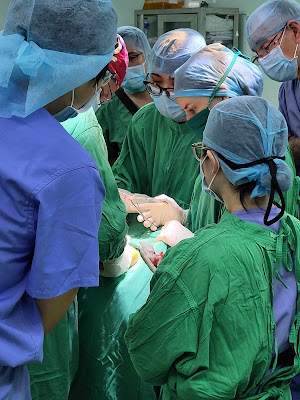The team completed its first day in the operating room on Tuesday. The surgeons and residents handled eight cases. Two included performing a Can Tho transfer, a technique the IEP team developed during a previous mission in Vietnam:
Chris Corrigan spent his first day in the operating room and shares his observations.- 8-year-old male: soft-tissue procedure, Can Tho transfer
- 15-year-old male: bony and soft-tissue procedures
- 16-year-old male: bony and soft-tissue procedures
- 43-year-old female: soft-tissue procedure, Can Tho transfer
- 28-year-old male: bilateral soft-tissue procedure
- 64-year-old female: bony procedure
- 54-year-old female: bony procedure
- 55-year-old male: bony procedure
It’s hard to comprehend what I can only label as the extreme confidence of the people in the operating room. To cut through skin, muscle, tendon, and ligaments. Saw through bone. To see the connections and inner workings of the human body and understand how it all fits together. And how it can be taken apart, reworked, and put back together again.
Being in the hospital with the IEP team is like having a backstage pass and working with the stage crew for the most intricate show on earth. There is a humbling level of nerve on display. I get nervous about changing the batteries in my TV remote. I’m terrified of losing the screws when I’m putting together IKEA furniture. And these people are taking limbs apart, re-fastening them, and putting them back together. Part mechanic, part sculptor, with no signs of doubt or second-guessing. They are single-minded, focused, clinical. Surgical.
I have a new appreciation for those adjectives: clinical and surgical. I’ve always understood their meaning as well as their etymology. (I was an English major, after all.) It’s the way of looking at situations and the world with precision and free of emotion. I even understand its relationship to the world of medicine, where everything needs to be precise. I can wrap my head around that. It makes sense, even in the abstract.
Observing the work of the surgery teams, the words become more powerful. Concrete. It’s like my previous understanding of these words is pumped up on steroids. Clinical. Surgical.
But I still wonder. Here’s a kid who wants to play soccer, ride a bike, walk to school, run down the street, or meet a friend. How does a doctor separate the patient’s body from his life — family, past, future. How do you compartmentalize the person from the body?
At the operating table, do the doctors push aside their feelings and emotions in the moment? Do they perceive the patient’s hopes and fears?
I asked Bruce Lehnert about it. “A surgeon knows what they know and does well and stays in that box,” he said. “Yes, you hear the voices, but know you can do it. You stay in your lane, do your thing in your moment, focus on it, stick with it.”
Confidence. It’s not swagger, it’s focus. It’s knowing yourself. It’s not arrogance, will, or ego. It’s self-awareness — paramount, supreme, comfortable self-awareness.
I watch a woman as she is wheeled out of the operating room after surgery. From her gurney, she waves at one of the attending nurses. I realize this is the right stuff.


Comments
Post a Comment